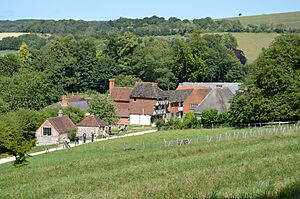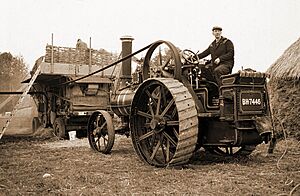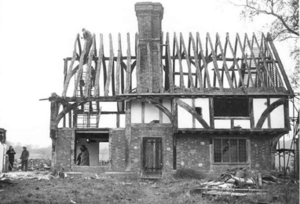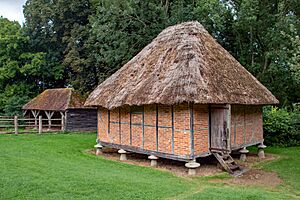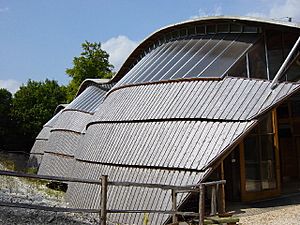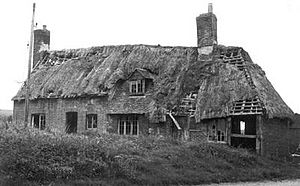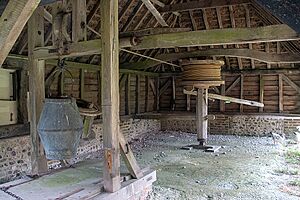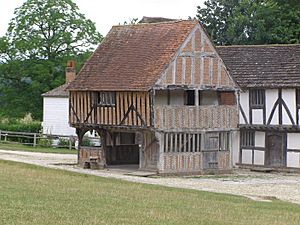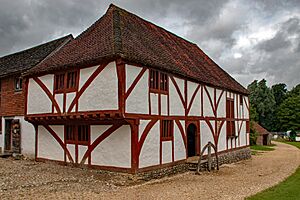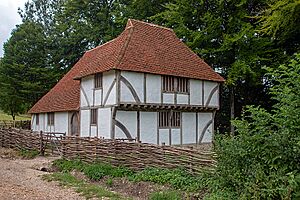Weald and Downland Living Museum facts for kids
The Weald and Downland Living Museum is a special open-air museum located in Singleton, West Sussex. It used to be called the Weald and Downland Open Air Museum until January 2017. This museum is a registered charity, which means it's a non-profit organization that helps the community.
The museum is huge, covering about 40 acres (that's like 30 football fields!). It has over 50 old buildings from different times, ranging from the year 950 AD all the way to the 1800s. You can also explore beautiful gardens, see farm animals, enjoy walks, and visit a mill pond.
The main goal of the museum is to save important old buildings from South East England. These buildings show how people used to live and work. The museum tries to keep buildings where they originally stood if possible. But if a building is in danger, they carefully move it to the museum. This helps everyone learn about how people built things long ago.
All the buildings at the museum were going to be destroyed. Since they couldn't stay in their original spots, they were carefully taken apart. Then, they were put back together at the museum, looking just like they did in the past. These buildings, along with two rebuilt ancient structures, help bring history to life. You can see how homes, farms, and old workshops looked over the last 950 years. The museum also offers fun "hands-on" activities, like learning to cook or weave. They also have special events throughout the year, like seasonal shows and a historic gardens weekend.
Contents
- Discovering the Museum's History
- Exploring Historic Buildings
- Aisled Barn: A Look at Old Building Methods
- Cowfold Barn: A Medieval Farm Building
- Bayleaf Farmhouse: A Home from the 1400s
- Brick-Drying Shed: Making Bricks in the Past
- Carpenter's Shop: Tools of the Trade
- Cattle Sheds: Homes for Farm Animals
- Charcoal Burner's Camp: Making Fuel from Wood
- Court Barn: A Place for Exhibitions and Filming
- Crane: Lifting Heavy Things
- Granary: Storing Grain Safely
- Gridshell: A Modern Building for Old Collections
- Hall: A Medieval Meeting Place
- Hangleton Cottage: A Peasant's Home
- Horse Whim: Pumping Water with Horse Power
- Lavant House: An Education Hub
- Walderton House: A Flint-Walled Home
- Joinery Shop: Learning About Building
- Longport Farmhouse: A Kentish Home's Journey
- Market Hall: A Town's Meeting Place
- North Cray Medieval House: A Red-Painted Home
- Sole Street Medieval House: A Hands-On Experience
- Medieval Shops: A Glimpse into Old Commerce
- Open Shed: A Cart and Saw Shed
- Pendean Farmhouse: A Furnished 1600s Home
- Poplar Cottage: A Small Thatched Home
- Plumber's Workshop: A Place for Craftsmen
- Pugmill House: Preparing Clay for Bricks
- Saw-Pit Shed: Turning Trees into Timber
- School: Education from the 1800s
- Stable: Home for Horses and Oxen
- Shelter Shed: A Simple Cover
- Smithy: The Blacksmith's Workplace
- Treadwheel: A Human-Powered Machine
- Tindalls Cottage: A Home from the 1700s
- Toll Cottage: Collecting Road Fees
- Upper Hall: A Community Meeting Place
- Wagon Shed: Storing Farm Wagons
- Watermill: Grinding Grain with Water Power
- Whittaker's Cottages: Two Homes, Two Styles
- Windpump: Pumping Water with Wind
- Winkhurst Kitchen: A Tudor Cooking Space
- Meet the Museum Animals
- Awards and Recognition
- Filming at the Museum
- See also
Discovering the Museum's History
The Weald and Downland Open Air Museum started in 1967. A group of people who loved history, led by Dr. J.R. Armstrong, created it. A local landowner, Edward James, gave the land for the museum for a very small rent. The idea was to save old buildings that were going to be torn down. The museum first opened its doors to visitors on September 5, 1970.
The idea of an open-air museum was already popular in places like Scandinavia. It's a way to create a real-life setting to show how people lived and worked in the past. These museums help you understand the tools, furniture, clothes, and art of different time periods by seeing them in their original types of buildings.
Exploring Historic Buildings
Aisled Barn: A Look at Old Building Methods
This large barn was built around 1771 at Prior's Leaze Farm in Hambrook, Sussex. It has a wooden frame made of oak and elm, with walls covered in weatherboards. The roof is thatched with reed. A special feature of this barn is its aisle, which goes all the way around the building. This design creates a continuous roofline, except for the tall barn doors. These doors were needed to let wagons full of crops drive inside.
Today, this barn has an exhibit that shows traditional building materials and methods. You can learn about bricklaying, glasswork, lead work, iron work, tiling, and thatching. During repairs, the year 1771 was found scratched on an original roof beam. This likely shows when the barn was first built.
Cowfold Barn: A Medieval Farm Building
This wooden-framed barn is from the 1500s. It originally stood in Cowfold, Sussex. It's a great example of a late-medieval barn from the Weald area. Scientists used tree-ring dating (called dendrochronology) to study the wood. They found that the trees were cut down in 1536, so the barn was probably built soon after that. At the museum, it's placed next to the Bayleaf farmhouse to create a complete farm scene.
Bayleaf Farmhouse: A Home from the 1400s
Bayleaf farmhouse is a timber-framed house with a tiled roof, built in the early 1400s. It has four rooms downstairs and two upstairs. In the main upstairs room, the windows have sliding wooden shutters. There's even a small toilet room called a garderobe. This house was originally in Ide Hill, Kent. It was given to the museum in 1968 because a new reservoir was going to flood its original location. The building was carefully taken apart in the winter of 1968–69.
Brick-Drying Shed: Making Bricks in the Past
This long shed was originally at the Causeway Brickworks near Petersfield, Hampshire. It's 80 feet long and was built in 1733. Now, it shows how bricks were made long ago. The Causeway Brickworks closed during the Second World War. This happened because the bright glow from the open-top kiln (oven) could be seen by enemy aircraft.
Carpenter's Shop: Tools of the Trade
This carpenter's shop was built in Windlesham, Surrey, in the late 1800s or early 1900s. It has a simple wooden frame, with the main posts dug directly into the ground. The walls are made of vertical boards, covered with strips to seal the gaps. The whole building was protected with a coating of tar.
When the museum received the workshop, it still had many of the tools and materials the carpenter used. The workbenches were in place, and some tools were still on their racks or in their boxes.
Cattle Sheds: Homes for Farm Animals
Five open-fronted cattle sheds, built between the 1700s and 1800s, have been rebuilt at the museum.
- A small, three-bay shed from Lurgashall is near the Bayleaf farmhouse.
- A seven-bay shed from Kirdford is now next to a shed from Goodwood. Together, they form two sides of a farmyard.
- The shed from Goodwood has a shepherd's room at one end. This suggests it might have been used for sheep as well as cattle. This shed now displays horse-drawn farm tools.
- A shed from Rusper is part of the museum's working-horse stables.
- Another shed from Coldwaltham is next to the charcoal burner's camp.
Charcoal Burner's Camp: Making Fuel from Wood
The charcoal burner's camp was one of the first exhibits when the museum opened in 1970. Making charcoal was the first old trade shown here. The camp shows how charcoal is made. The kiln (oven) had to be watched all the time, so the charcoal burner lived nearby in a hut.
The camp was recently updated with advice from retired charcoal burners. These experts had used traditional earth-covered kilns until 1948.
Court Barn: A Place for Exhibitions and Filming
Court barn was built in the late 1600s or early 1700s. It originally stood in Lee-on-Solent, Hampshire. It had a central area for threshing grain and storage bays. There's even a small loft above the entrance for owls! This building now holds exhibits about how lead was used in buildings and plumbing, as well as stonemasonry and stained glass work. The barn was taken apart in 1976 and rebuilt at the museum in 1980. The BBC TV show The Repair Shop has been filmed here since 2017.
Crane: Lifting Heavy Things
This crane was made in 1900 by John Smith Ltd in Keighley, Yorkshire. It was first used on a farm in Alton, Hampshire. It can lift up to 5 tons and is operated by hand. It's now part of a rebuilt timber yard at the museum.
Granary: Storing Grain Safely
This granary was built in 1731 in West Ashling, Sussex. It has a wooden frame filled with bricks and a thatched roof. It's about 20 feet square, making it one of the larger granaries. It stands on sixteen special stone supports called staddle stones. These stones helped keep mice and other pests from getting into the stored grain.
Gridshell: A Modern Building for Old Collections
The Weald and Downland Gridshell was built between 2000 and 2002. It's a very modern and unique building. Its main purpose is to store the museum's collection of rural life items in a way that's easy to access. It also has the museum's workshops where old items are repaired, and an exhibition area in the front. This building has won many awards for its design.
Hall: A Medieval Meeting Place
This medieval hall house was built in the 1400s in Boarhunt, Hampshire. It has a special cruck frame construction, with brick walls and a thatched roof. The building was saved in 1971. Photos show that the house was once twice its original size, but only the medieval part was moved to the museum. The hall is about 17 feet square. Only about 30% of the original wood was used in the rebuilt structure. This was allowed because the remaining original pieces were spread out well, and because of its unique cruck frame.
Hangleton Cottage: A Peasant's Home
This small, flint-built, thatched medieval cottage is based on two homes found during digs at the deserted medieval village of Hangleton, Hove. Archaeologists found eight buildings from the 1200s and 1300s. Hangleton cottage shows what a typical peasant's home looked like back then. It has a main room with an open fireplace and an inner room with an oven. Hangleton became smaller during a time of farming problems between 1315 and 1322, and then after the Black Death in 1348. By 1428, only two homes were left there.
Horse Whim: Pumping Water with Horse Power
The horse whim is inside an open-fronted, thatched shed that was originally in Charlwood, Surrey. A horse would walk in a circle to power this machine, which was used to pull water up from a well. The horse whim itself was originally built in West Kingsdown, Kent. The museum saved it in 1980 and rebuilt it in 2000.
Lavant House: An Education Hub
This house dates from the 1600s and originally stood in Lavant, West Sussex. From the outside, it looks like it did in the 17th century, but the inside is modern. This building is now used as an education room for school groups and young visitors to the museum.
Walderton House: A Flint-Walled Home
This house was originally built in Walderton, Sussex. It has a timber frame from the 1400s, with flint stone walls added in the 1600s. It has a thatched roof.
Joinery Shop: Learning About Building
The joinery shop was built in Witley, Surrey, in the late 1800s or early 1900s. It has an exhibition that teaches visitors about how buildings are constructed.
Longport Farmhouse: A Kentish Home's Journey
The Longport Farmhouse is a typical Kent farmhouse. It used to be in Folkestone, Kent, but was in danger because of the construction of the Channel Tunnel. The oldest part of the building is from 1554. It was once connected to a medieval hall that no longer exists. Over the years, from the late 1500s to the early 1900s, many additions and changes were made to the farmhouse.
The farmhouse was taken apart in 1992 by a team from the museum and the Canterbury Archaeological Trust. It was rebuilt in 1995. During the rebuilding, the museum tried to make it look exactly as it did in the early 1900s, showing all its different stages of change. The 17th-century chimney was not rebuilt, but it was carefully taken apart and recorded so it could be rebuilt later. By leaving it out, the museum created an open space inside. This space now serves as the entrance and shop, and helps show how the farmhouse changed over time. The farmhouse also holds the museum's offices.
Market Hall: A Town's Meeting Place
The Market Hall is from the 1600s and was originally built in Titchfield, Hampshire. It has a small jail cell on the ground floor. The room upstairs was used as the town council's meeting place. When the Market Hall was taken apart and rebuilt at the museum, it was actually the second time it had been moved! It had already been moved from its original spot in the center of Titchfield to another place in town in the mid-1800s.
North Cray Medieval House: A Red-Painted Home
This medieval hall house was built in North Cray, Kent, probably in the 1400s. It has a timber frame and a tiled roof. The outside timbers are made of elm, which is unusual (oak was more common). They are painted red because there is evidence that this was the original color.
Sole Street Medieval House: A Hands-On Experience
This medieval hall house was originally built in Sole Street, Kent. It has a timber frame and a tiled roof. Today, this building is used for craft demonstrations. Visitors can get a hands-on experience and try out old crafts here.
Medieval Shops: A Glimpse into Old Commerce
This building dates from the 1400s and holds two shops. It was originally built in Horsham, Sussex. This three-story building has upper floors that stick out over the lower ones. It's timber-framed with a tiled roof. The upper floors are now used as the museum's library and are not usually open to the public.
Open Shed: A Cart and Saw Shed
This open shed is from the 1700s. It was originally built in Charlwood, Surrey. It was used to store carts and also as a saw shed. The shed was taken apart in 1999. When it was rebuilt at the museum in 2000, the horse whim from West Kingsdown, Kent, was put inside it.
Pendean Farmhouse: A Furnished 1600s Home
This hall house was built in West Lavington, West Sussex, in 1609. Instead of an open hall, it has a central chimney with fireplaces on both the ground and first floors. It still has some features from the 1500s, like windows without glass. The building has a timber frame with bricks filling the gaps on the ground floor and wattle and daub (a mix of sticks and mud) on the first floor. It was rebuilt at the museum in 1975. Later, a postcard of the original building showed that the chimney hadn't been rebuilt quite right. So, the chimney was rebuilt again in January 2001 to be more accurate. The house is now furnished to look like it did in that time period.
Poplar Cottage: A Small Thatched Home
Poplar cottage is a small, timber-framed, thatched building from the 1600s. It was originally built in Washington, West Sussex. The building dates from between 1550 and 1630. It was given to the museum in 1982 and carefully taken apart that same year. It was rebuilt in 1999 with help from a grant.
- Rebuilding Poplar Cottage
Work on rebuilding Poplar cottage started on April 10, 1999. The wooden timbers had been prepared during the previous winter. The outside wall of the smoke bay was filled with sandstone, while the rest of the building was filled with wattle and daub. The roof was then thatched.
Plumber's Workshop: A Place for Craftsmen
The plumber's workshop dates from the late 1800s and was originally built in Newick, Sussex. The upstairs floor was used as a glazier's (someone who works with glass) workshop.
Pugmill House: Preparing Clay for Bricks
This brick and stone building originally stood in Redford, Sussex. It held a horse-powered pug mill. This machine was used to prepare clay, making it ready for brickmaking.
Saw-Pit Shed: Turning Trees into Timber
This 19th-century shed was originally built at Sheffield Park, Sussex. It now displays a variety of tools that were used to turn trees into finished wood.
School: Education from the 1800s
This building is from the 1800s. It was used as a school for poor children in the early part of that century. It was originally built in West Wittering and is made of brick and flint with a tiled roof.
Stable: Home for Horses and Oxen
This stable dates from the mid-1700s and was originally built in Watersfield, Sussex. It has a timber frame, covered in weatherboarding, and a tiled roof. This building can house up to five horses or oxen.
Shelter Shed: A Simple Cover
This open-fronted shelter shed was originally built in Coldwaltham, West Sussex.
Smithy: The Blacksmith's Workplace
The smithy was built in the mid-1800s. It was originally located in Southwater, Sussex.
Treadwheel: A Human-Powered Machine
This treadwheel dates from the early 1600s. It was probably not powered by a horse because of its size. The treadwheel is inside a small timber-framed building with a thatched roof. It was originally built in Catherington, Hampshire.
Tindalls Cottage: A Home from the 1700s
Tindalls Cottage, built around 1700–1725, is an oak-framed building with a tiled roof and a chimney at the end. It was originally from Ticehurst, East Sussex. It was taken apart in 1974 before the Bewl Water reservoir was built. The cottage gets its name from the Tindall family, who lived there from 1748 to 1806.
Toll Cottage: Collecting Road Fees
This toll cottage is a typical example from the 1700s and 1800s. It originally stood on a road built in 1807 in Upper Beeding, Sussex. At the museum, it has been set up with a recreated tollgate and a milestone (a stone marker showing distance).
Upper Hall: A Community Meeting Place
This building dates from the 1400s. It has a long, open room on the first floor, which was probably used as a community meeting place. It was originally built in Crawley, Sussex, behind Tree House, which was the old manor house of Crawley. The building was going to be torn down for an office building extension. Only two complete sections of the original four bays remained, plus a third of another. The original building would have been about 36 feet long. The original roof was made of Horsham Slab, but this was replaced when the building was rebuilt at the museum. Only the middle part of the current building is original. The ends are modern reconstructions that look like the original parts. The building is used as the museum's library and meeting place and is not usually open to the public.
Wagon Shed: Storing Farm Wagons
This wagon shed dates from the 1700s. It was originally built in Wiston, West Sussex.
Watermill: Grinding Grain with Water Power
The watermill dates from the early 1600s and was still working until 1935. It is now in working order, and you can buy flour from the mill in the museum shop! The mill was originally built in Lurgashall, Sussex, to serve Petworth House and Park. At one time, it might have been used to grind bark for the tanning process (making leather). In 1968, the old mill was damaged by floods, causing the heavy millstones to fall through the rotting floors.
The mill was originally powered by a small river. At one point, the mill had two waterwheels, each turning two pairs of millstones. The 12-foot diameter waterwheel, which was originally made for another mill, now powers two pairs of millstones, a sack hoist (to lift sacks), and a flour dresser (to sift flour). The machinery in the mill was installed in 1911. The mill was given to the museum in 1973 and carefully taken apart. During this process, evidence was found that the site was once used as a Hammer mill (for working iron). It took seven years to rebuild and restore the machinery.
Whittaker's Cottages: Two Homes, Two Styles
Whittaker's cottages are a pair of wooden cottages with a slate roof. They were originally built in Ashtead, Surrey. One cottage is furnished to show how it looked in the 1800s. The other is unfurnished so you can see how it was built.
Windpump: Pumping Water with Wind
| Westham windpump | |
|---|---|
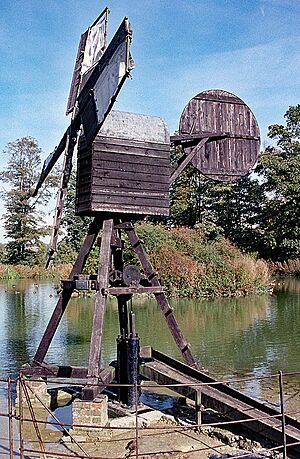 |
|
| Origin | |
| Grid reference | SU 8744 1285 |
| Coordinates | 50°54′29″N 0°45′29″W / 50.908°N 0.758°W |
| Operator(s) | Weald and Downland Open Air Museum |
| Year built | Mid-19th century |
| Information | |
| Purpose | Pumping water |
| Type | Hollow post mill |
| No. of sails | Four |
| Type of sails | Boarded sails |
| Winding | Windvane |
| Type of pump | Plunger pump |
This windpump is a hollow post mill that was built in the mid-1800s. It was originally in Westham, Sussex, and was shown on a map from 1860. The windpump was rebuilt at the museum in 1975.
Winkhurst Kitchen: A Tudor Cooking Space
This 16th-century building was originally part of a larger building in Sundridge, Kent. It has a timber frame with a special crown-post roof. The building dates from between 1492 and 1537. It was the very first building the museum acquired! It was taken apart in 1968 and rebuilt at the museum. However, that first spot wasn't ideal. So, it was decided to take the building apart again and rebuild it in a different spot within the museum. This time, modern additions were designed to help visitors understand the building better. The building was taken apart in December 2001 and rebuilt for the second time between February and May 2002. The inside of the building has been recreated as a working Tudor kitchen.
Meet the Museum Animals
The museum has a variety of farm animals that would have been common in the past. You can see Southdown sheep, Sussex chickens, and Embden geese. They also have some rare saddleback pigs on loan. In addition, the museum has strong Percheron horses. These horses help pull the different horse-drawn vehicles and farm tools.
Awards and Recognition
Since it started, the museum has won many awards for its work and its special collection.
- 2018 – Public and Community Award, Sussex Heritage Trust. This was for the museum's Gateway Project (visitor center), which improved facilities for the community.
- 2017 – Sandford Award for Education, Heritage Education Trust.
- 2016 – Queen's Award for Voluntary Service. This is the highest award a volunteer group can get in the UK. It was given to the museum's volunteers for helping people learn about old crafts and rural buildings.
- 2015 – Balfour of Burleigh Tercentenary Prize. This award went to Roger Champion, the Museum Master Carpenter, for his amazing achievements in crafts.
- 2015 – Sussex Visitor Attraction of the Year.
- 2015 – Sussex Heritage Person of the Year, Sussex Heritage Trust. Awarded to Richard Pailthorpe, the Museum Director.
- 2012 – Sussex Heritage Person of the Year, Sussex Heritage Trust. Awarded to Roger Champion, the Museum Master Carpenter.
- 2011 – Europa Nostra Award. The museum received a European Union Prize for Cultural Heritage/Europa Nostra Award for its program that trains people in historic building conservation. They also won a Grand Prix Laureate for outstanding heritage achievements.
- 2001 – Sandford Award for Education, Heritage Education Trust.
- 1998 – Designated Outstanding Collection. The museum's entire collection was recognized as an important collection of national (and sometimes international) importance by the government.
- 1997 – Sandford Award for Education, Heritage Education Trust.
- 1989 – Times/Shell Community Museum Award. The public voted for this award, and it was given by the Duchess of York. It recognized the huge support the museum received from the local community.
- 1975 – National Heritage Museum of the Year Award. This was one of the first independent museums to receive this award, which is now called the Art Fund Prize for Museum of the Year.
Filming at the Museum
The museum has been a popular spot for filming movies and TV shows. Its old buildings, historic interiors, and beautiful landscapes make it perfect for creating authentic historical scenes.
Many productions have been filmed at the museum, including:
- Amazon Prime Video Good Omens (October 2017)
- BBC1/BBC2 The Repair Shop (May 2017–present)
- CBeebies My Story Specials: Great Fire of London (October 2016)
- Wall to Wall (for BBC2) Victorian Bakers (January 2016)
- BBC Films & Koch Media Bill (September 2015)
- BBC Countryfile (September 2015)
- BBC The Hollow Crown Henry VI part II (January 2015)
- Freemantlemedia Ltd Escape to the Country (October 2013)
- Lion TV Tudor Monastery Farm (April – October 2013)
- BBC Flog It! (February 2013)
- 360 Productions Ltd The Time Travellers Guide to the Elizabethans (November 2012)
- BBC Hairy Bikers (September 2012)
- STV Productions Celebrity Antiques Road Trip (June 2012)
- Silver River Restoration Women (April 2012)
- Shakespeare Productions Ltd Henry VI parts (January 2012)
- Lion TV The Link (August 2011)
- BBC The One Show with Ruth Goodman (January – February 2011)
- Endemol Restoration Village – The Final (September 2010)
- Hallmark Entertainment The 10th Kingdom (2000)
- BBC If Walls Could Talk with Lucy Worsley (September 2009 & February 2010)
- Endemol for the BBC Restoration Village – The Final (September 2009)
- Talkback Thames Escape to the Country (July 2009)
- Antix Productions Most Haunted (May 2009)
- BBC Countryfile featuring the museum's Tree Dressing Event (Dec 2008)
- Maya Vision Int Christine of Codicote (March 2008 & Oct 2009)
- BBC Tweenies (4 September 1999, Old House episode only)
See also
- Tudor Monastery Farm
- Acton Scott Historic Working Farm, Shropshire
- Blists Hill Victorian Town
- Beamish Museum
- Morwellham Quay
- Manor Farm, River Hamble Country Park
- Butser Ancient Farm
- Castell Henllys
- St Fagans National Museum of History
- Highland Folk Museum


